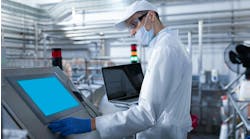Industrial machines are changing. No longer the single-purposed dinosaurs of the plant floor, modern
manufacturing assets are now computers, data-generators, data-analyzers, and—in a nutshell—more nimble than their rusting ancestors.
We chatted with John Kowal, B&R director of business development, to learn more about the current state of the adaptive machine. Take a look…
Smart Industry: Describe the concept of "the adaptive machine."
John: Simply put, it’s a machine that adapts to the product being made or packaged, instead of running sequences of identical products and changing over between runs. Instead of a process that is sequential, each product is independently controlled.
Smart Industry: What’s prompting this change in machine design? Are customers prompting the capability for batch-of-one?
John: We’re living in the age of the digital native—a generation of people who have never lived without the internet, without e-commerce, without connected devices at hand. The millennial generation is now the largest consumer segment in the North American economy, and they expect what they want, when they want it. These consumers aren’t driving machine design per se, but they are driving mass-customization and, ultimately, batch-of-one consumer packaged goods. That creates a problem for consumer-goods makers. You can manufacture manually if you have low-cost labor, but it only makes sense to make a lot and fill a container that will be six weeks in transit. It’s not economical to fulfill individual orders overnight from places where labor is still cheap. Consumer demand will drive re-shored, more localized, automated, small-batch manufacturing. But the major change in machine design to batch-size-one has been made possible by a combination of advances in electro-mechanical and automation technologies.
Smart Industry: How are these machines different in terms of operations/maintenance/personnel?
John: They fit perfectly into the smart-factory concept. Each order is turned into a unique recipe or bill-of-materials, and each product is independently controlled through manufacturing, assembly and packaging. This is where track technology comes into play. One product equals one shuttle that moves through whichever work stations it requires to produce to order. As far as the track technology itself, maintenance will vary by manufacturer. Ideally, the electro-mechanical design will have a minimum of wear parts, be robust and have easy-to-replace shuttles that don’t require stopping production. As with any advanced automated machinery, people operating or otherwise interacting with the machine should find a graphical interface that is easy to use and mechanical design that is ergonomic. Operations will see the most radical improvements, however. Changeover is constant, so there is no such thing as “changeover time” any more. Reconfiguration means simply changing, adding or removing modules.
Smart Industry: How does transition to adaptive machines alter business strategies?
John: Not every product will be conducive to manufacturing with adaptive machines. But where it does make sense, it will be possible to shift from a make-to-stock business model to make-to-order. Operationally this has positive implications for streamlined supply chains, finished-goods inventory costs and write-down of unsold goods. As a consumer-marketing strategy, mass customization can help a manufacturer win their customers back from retailers. It can help them become a better supplier to conventional and online retailers, since product can ship directly from the production line and never hit the retailer’s distribution centers. And by only manufacturing what is sold, the business model is more sustainable.
Smart Industry: Is the ability to respond to future/currently unknown changes a key component of adaptive machines?
John: This is an absolutely key justification for investment. This new level of flexibility can enable mid-size enterprises, regional and contract manufacturers, and decentralized manufacturing strategies at large enterprises, because the reconfigurability greatly reduces the risk of investing in capital equipment for a product that may have a short lifecycle. This is especially true in localized customization activities, such as contract packaging and rainbow packing of beverages and snacks. With highly configurable machinery, time-to-market is reduced because new products don’t necessarily require all-new production lines. Yet, it’s still beneficial to the machine builders, who are likely to enjoy greater customer loyalty since they are intimately familiar with the base machinery they supply.
Smart Industry: Why have rotary labeling machines been a natural fit here?
John: Servo rotary labelers, in particular, exhibit some of the attributes of the adaptive machine. Servo-driven bottle plates, for example, are individually controlled, similar to adaptive machine shuttles except that the labeling process remains sequential. Labeling aggregates are modules, so that aggregates for different label and adhesive types are wheeled in and clamped into place for efficient changeovers, but changeovers nonetheless.
Smart Industry: What is the greatest challenge in transitioning to adaptive machines?
John: Any new technology battles against resistance to change, due mainly to risk, so the first-mover advantage will go to business leaders with the vision and will to adopt early. To mitigate the perception of risk, initial investment can be limited to one system or cell, one product line, or even one region until proof-of-concept is achieved.
Smart Industry: What most excites you about this field?
John: That it’s finally happening. Track technology has been around for 15+ years. Now the automation technology and the commercial (from e-commerce through ERP) technology have caught up and made batch-size-one a practical reality.
It’s not unlike what GPS did for personal navigation once it went from cockpits to purpose-built consumer products to a standard feature on our personal devices.


